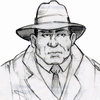The best Western and Japanese handsaws are quite thin yet in competent hands won’t kink in a cut, and the spring steel they are made from is tempered to allow sharpening with files. They are usually taper ground in two dimensions, so the blade’s cutting edge is thicker than the back, and both the back and the cutting edge taper from the saw’s heel to the saw’s toe. The thinner the cutting edge, the greater the taper, and the higher the polish, the higher the saw’s quality, as taper results in less set required for the teeth, aided by the steel’s polish that inhibits binding in the cut. All these features allow for a narrower kerf requiring less sawing effort.
There are two fundamental choices in manufacturing a thin saw that won’t kink. The least expensive choice is to make the saw stiff by using hard steel and disposable blades, because such saws can’t be economically resharpened. The second choice is to temper the saw so that it can be filed, and to stiffen it by tensioning the blade using hammer and anvil.
When a thin blade is struck on an anvil by a convex-faced round hammer, a dimple is created; often so small it can’t be seen by the eye. Steel from the area around the dimple is pulled inwards toward the point of impact, making the steel in the circular area radiating from the dimple stiffer, or “tensioned” on its surface. Hundreds of such hammer blows applied in certain patterns equally to both sides of a handsaw blade can make it stiffer, can true a warped circular sawblade, or can dish a large bandsaw blade to conform to its wheels while at the same time tensioning the cutting edge. Truing sawblades are not low-order skills, and the major saw factories and filing shacks of logging camps and commercial sawmills were where you found them. Today it’s largely done on computerized machines, except for hand saws. Here you either find an old, retired saw doctor who worked for a big mill, a Japanese saw maker still tensioning by hand, or are on your own because there are few references. I’m not going to make a saw doctor out of you today. But I can get you started with some basics to practice with on old sawblades.
This old saw has a 3/8” kink in the area marked in chalk, and before I do anything else to rehabilitate the saw, I’ll remove this kink and true the cutting edge.
The first step is to remove the handle and bend the blade using your hands in as complete a circle as possible….in both directions. This relieves any recent stress put in the saw, and sometimes makes the existing kink worse or reveals additional problems like bow or twist.
The tools I’ll use to remove the kink are a steel anvil and two hammers, both heavy and light, both with slightly convex faces. I’ll mark the areas to be struck with chalk and using and oily rag, keep all steel surfaces clean and oiled to prevent marking the blade.
Removing a kink or bow requires stretching the steel surface on the concave side of the kink, and compressing the surface on the convex side. Before doing either, the saw’s tension at the cutting edge needs to removed or my attempt may make the kink worse. I accomplish this on the concave side by striking along a line running an inch or slightly less upwards from the tooth gullets. Each “X” represents two light hammer hits. I made identical chalk marks on the opposite side of the saw, but I don’t attempt to strike them yet.
On the identical marks on the convex side of the kink, I’ll accomplish two tasks simultaneously using light hits with the heavy hammer. The heavier hammer strikes will both remove the tension from this side of the saw and straighten out the kink by reversing the conditions that caused it, compressing the near side and stretching the far side of the blade.
I sight down the cutting edge to insure I removed the kink and repeat the previous steps if necessary. Once the kink is removed, I tension the cutting edge using identical light hammer strikes on both sides of the saw in turn, around ¼” to 3/8” above the gullets, insuring I don’t strike the gullets or teeth.
When tensioning is complete, the saw should flex in either direction as I did at the beginning, and return to dead straight.
Continued....













 Reply With Quote
Reply With Quote















